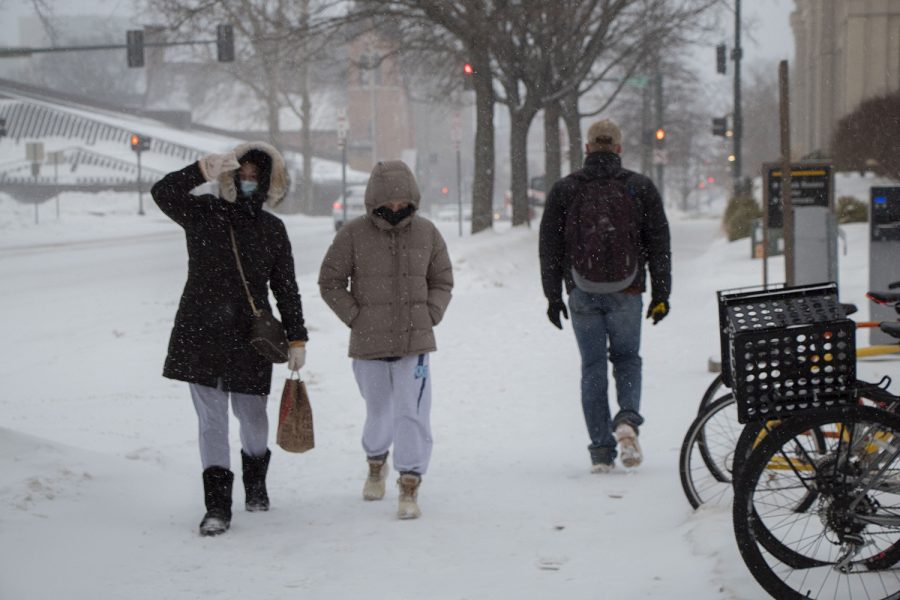City leaders concerned snow piles create accessibility issue
Before Monday’s snowstorm in Iowa City, City Councilor John Thomas expressed his concerns with the current snow clearing policies, saying it prioritizes vehicular mobility and accessibility rather than pedestrians’.
Students are seen walking to and from class in the snow at the University of Iowa on Monday, Jan. 25, 2021.
January 26, 2021
Snow plows have been busy clearing Iowa City streets after Monday’s snow storm, which brought about 7 inches of snow to the area, according to the National Weather Service.
Snow plowing on city and residential streets can often lead to an accumulation of snow on sidewalk ramps, especially on street corners, which Iowa City City Councilor John Thomas said makes it difficult for people with strollers, wheelchairs, or physical impairments to access sidewalks.
Thomas recently expressed his concern over this inaccessibility to city and residential sidewalks before Monday’s snowstorm, posting in the Neighbors of the Northside Facebook group, which is associated with the Northside Neighborhood Association, that he would like the city’s snow clearing policy to be reconsidered.
“Last Tuesday, I asked Council to reconsider our snow clearing policy, specifically at the street corners, where curb ramps are sometimes inaccessible due to the piles of snow left by our street plowing operations,” Thomas wrote in the Northside Neighborhood Association.
Iowa City Neighborhood Outreach Services Coordinator Marcia Bollinger said she is aware of the frustration community members may feel with the buildup of snow at these intersections and sidewalk ramps, especially those who use wheelchairs or strollers.
“We all want to hopefully keep the perspective that we’re talking about six weeks maybe at the most, that we’re dealing with this kind of challenge, and sometimes not even that much,” Bollinger said. “But if you’re in a wheelchair and you’re trying to get from point A to point B, it is a big deal.”
RELATED: Snowstorm to drop up to 9 inches of snow in Iowa City area
The current policy encourages property owners to hold the responsibility of clearing the piles of snow that accumulate on the sidewalk ramps at street corners. Thomas said Iowa City does not, however, have the ability to enforce this.
Thomas said he finds the current policy to entrust a difficult task with corner property owners. He said it is challenging to properly clear the buildup of snow, and there have been incidents where the snow will reaccumulate after another snowplow goes by, forcing the property owner to clear the street corner an additional time.
“I felt it was unfair to hold the corner property owner responsible for the ramps because most of the snow that we’re talking about is generated through plowing operations,” Thomas said. “That’s the city’s own work that’s creating the obstruction, so it seems to me that the city should take some responsibility for those mounds of snow at the curb ramps, and it can be done, to some degree at least, according to the guidelines, through more careful plowing operations so it doesn’t end up there.”
Thomas said he has conducted research and learned how other cities, such as Minneapolis, have handled clearing this buildup of snow on street corners, which are alternately referred to as “snow windows.”
“I wanted to make it clear that there are really a wide range of responses that cities have regarding that policy and that some really take a very high level of responsibility for removing snow from sidewalks and curb ramps,” Thomas said. “That really helped me understand that the way we do it here isn’t the only way it’s done.”
RELATED: Some UI students say snow, ice bring accessibility issues
In a work session on Jan. 19, Thomas asked the city council to look at this current policy and consider the proposed change to the current snow clearing procedures.
Iowa City Director of Public Works Ron Knoche said since Thomas approached the council with this reconsideration of policy, he and other department heads have been tasked with gathering data and looking into how other cities across the Midwest handle snow clearing, especially along city and residential street corners.
“We’re trying to determine how other communities are dealing with this, and then come up with what’s the best option for our community,” Knoche said.
Knoche said he hopes that, with the research the department is currently conducting, the city is able to find a reasonable and efficient way to clear snow in future circumstances and adjust the current policy accordingly.
“There’s the balance of impact both from a staffing standpoint, from a budgetary standpoint, and then also from a community standpoint,” Knoche said. “Obviously the goal of any research that we’re doing is if there will be change in the way the policies are being handled now, and that there is an outcome that is a reasonable way of handling the situation.”






